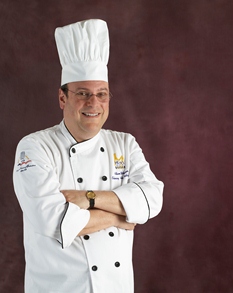U.S. Receives Gold at Dubai World Hospitality Championship 2013
Monday, 09 December 2013 15:04
 Several foodservice educators contributed to the American Culinary Federation’s chef team’s second-place win among 12 teams in Dubai.
Several foodservice educators contributed to the American Culinary Federation’s chef team’s second-place win among 12 teams in Dubai.
The American Culinary Federation (ACF) culinary-competition team received a gold medal at the Dubai World Hospitality Championship 2013, Dubai, UAE, Nov. 16-18, giving the United States second place overall in the international competition. Singapore’s culinary team placed first and Australia’s team was third.
“The U.S. team worked together to represent the fresh, unadulterated flavors of American cuisine,” said Edward Leonard, CMC, WGMC, AAC, team captain. “After two months and three practice sessions, we finished second against 11 other countries and achieved our goal of a gold medal based on flavors, craftsmanship and teamwork. My toque is off to my fellow chefs in pastry and cuisine. They excelled in this competition with passion, pride and a quest to be the best.”
ACF organized a team of seven chefs at the invitation of His Highness Sheikh Hamdan Bin Mohammed Al Maktoum, Crown Prince of Dubai, to represent the United States at the inaugural international competition held at the Dubai World Trade Centre. The ACF team competed against 11 other teams from Australia, Brazil, Canada, Germany, Hong Kong, Russia, Singapore, Slovenia, South Africa, United Arab Emirates and Wales.
The seven U.S. chefs competing were:

 Chef Jason Ziobrowski of InHarvest inspires culinary grads of Victory Trade School.
Chef Jason Ziobrowski of InHarvest inspires culinary grads of Victory Trade School. Through the free videos he helps produce for Unilever, Steve Jilleba stresses the need among current and future cooks to understand culinary origins and the impulses that inspired authentic flavors around the globe.
Through the free videos he helps produce for Unilever, Steve Jilleba stresses the need among current and future cooks to understand culinary origins and the impulses that inspired authentic flavors around the globe. Through culinary and reflective journaling, students can become empowered to consider broadly and deeply what they are learning and what they need to do in the future. Your role is simply to encourage them to write.
Through culinary and reflective journaling, students can become empowered to consider broadly and deeply what they are learning and what they need to do in the future. Your role is simply to encourage them to write. Give back, says Chef Weiner, and teach your students to, as well. Whether self-serving, altruistic or both, the many rewards—both personal and professional—far outweigh any inconvenience.
Give back, says Chef Weiner, and teach your students to, as well. Whether self-serving, altruistic or both, the many rewards—both personal and professional—far outweigh any inconvenience.